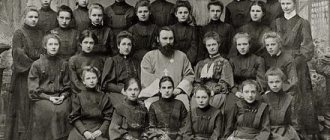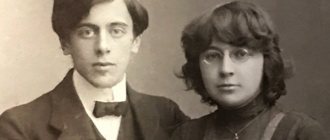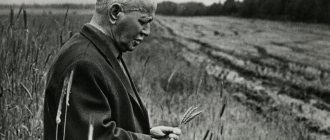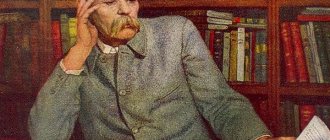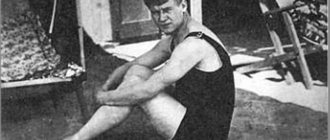Childhood and youth
“We all come from childhood” - this expression suits Vitaly Bianchi like no one else. The boy was born and raised in an amazing environment. Father Valentin Lvovich, head of the ornithological department of the zoological museum of the St. Petersburg Academy of Sciences, set up a real zoo at home.
Vitaly Bianchi in childhood (bottom left), his parents and brothers
The rooms were filled with cages with birds, adjacent to an aquarium and terrarium with lizards, snakes and turtles. The family, taking the animals, went to the village of Lebyazhye for the summer. Once, a moose calf, picked up by the rangers, even settled in the courtyard of Bianchi’s dacha, but in the fall the animal was placed in a zoo.
An even more fascinating world opened up in nature, which the father was in a hurry to introduce the children to. His sons wandered through the forests with him, recorded observations, learned to hunt and fish. Interest in nature and science determined the children's professions. The eldest son devoted his life to entomology, the middle one became a meteorologist. And the youngest, Vitaly, saw himself as an ornithologist, having been impressed by trips to Lebyazhye, where the great sea route of migratory birds lay.
Vitaly Bianchi in his youth
Love for animals is not Vitaly’s only childhood passion. The boy wrote poetry, respected music and sang well, and also played football well. After graduating from high school, the future writer entered St. Petersburg University, the department of natural sciences, but the First World War made adjustments - the young man was mobilized.
Vitaly Bianchi was interested in politics in his youth, joined the Social Revolutionaries, and walked under the banner of Kolchak. He later paid for the sins of his youth. The man was persecuted by the Soviet authorities, arrested on suspicion of counter-revolutionary activities, and once even deported to Uralsk (Kazakhstan).
Vitaly Bianchi in his youth
After the October Revolution, Vitaly Valentinovich lived for several years in Altai, in the city of Biysk. Here the writer gave lectures on ornithology, worked in the local history museum, introduced schoolchildren to the basics of biology, organized scientific expeditions and wrote stories for children.
Brief biography of Vitaly Valentinovich Bianki for primary school children
Vitaly Valentinovich Bianki was born in 1894 in St. Petersburg.
His father, an ornithologist, had a considerable influence on his son.
Vitaly often visited his father’s museum and went with him into nature.
At the gymnasium, Bianchi began to play football seriously and participated in competitions.
After high school, the future writer entered the university, but a few months later he was drafted into the army.
Vitaly Valentinovich worked in the field of education in various positions.
He often wrote down his observations of nature, animals, and insects.
And his most famous book was “Forest Newspaper”.
During his life, Bianchi published more than 120 books, and his works were published in 18 countries.
Vitaly Valentinovich Bianchi died on June 10, 1959.
_______
Literature
Vitaly wrote down his observations of the life of animals - these notes became the basis of his works about nature. The author's bibliography contains more than 300 fairy tales, stories, articles and stories, and 120 books were published. The writer once admitted in an address to readers:
“I tried to write in such a way that fairy tales would be interesting to adults as well. But now I realized that I was creating for adults who kept a child in their souls.”
Vitaly Bianchi's literary talent blossomed after returning from Altai to his hometown in 1922. In Leningrad, he joined the circle of children's writers Samuil Marshak and plunged headlong into creating a world woven from the chirping of birds, the greenery of grass and the adventures of animals.
Vitaly Bianki watches birds
The first fairy tale, “The Journey of the Red-Headed Sparrow,” was appreciated by young readers, and in gratitude they received a number of separate books: “Forest Houses,” “Mouse Peak,” “Whose Nose is Better?”
More than one generation of children read the miniature humorous stories “How the Ant Hurried Home,” “The First Hunt,” “Bear-Bashka,” “Teremok,” “Owl,” etc. In 1932, the writer’s first large collection, “Forest,” appeared in bookstores. There were also fables.”
Vitaly Bianki with pets
Young parents are sure to replenish their home library with the fairy tale “Titmouse’s Calendar,” which in a playful way introduces kids to the changing seasons and months. It’s a pleasure to explore the world together with Zinka the titmouse. On the pages of the book are answers to questions about why rivers freeze, when birds fly in and out, and many other interesting facts about animals and nature.
An extraordinary work that had no analogues in literature was the book “Forest Newspaper”. Vitaly Bianchi began this work in 1924; until 1958, 10 editions were published, which were constantly supplemented and changed in appearance.
Books by Vitaly Bianchi
An encyclopedia, a calendar, a game - this is all about the “Forest Newspaper”, consisting of 12 chapters, each dedicated to a month of the year. The writer put the material into newspaper genres: telegrams, advertisements, chronicles and even feuilletons containing news about the life of the forest appeared on the book’s page. "Lesnaya Gazeta" was warmly received by children in other countries - the book was translated into several languages.
Vitaly Valentinovich received additional recognition from the radio program “News of the Forest,” which was loved by young listeners in the 50s. Bianchi explained that the educational program was conceived as a gift to post-war children - “so that the children would not be bored, but would be happy.” “News from the Forest” was broadcast once a month; the program was also a kind of calendar.
Writer Vitaly Bianchi
The unfinished book “Bird Identifier in the Wild” put an end to the writer’s creative biography. In his diary Vitaly Bianchi wrote:
“There is a certain cheerful force living inside me. I see: everything that I had and still have that is good and bright in life... comes from this power. She is blessed both in me and in others - in people, birds, flowers and trees, in earth and in water.”
V.V.Bianchi. Biography presentation for the lesson (reading, grade 3) on the topic
Slide 1
BIANCHI VITALY VALENTINOVICH About the life and work of the writer
Slide 2
BIANKI V.V. (1894–1959) Vitaly Bianchi was born in St. Petersburg. He got his melodious surname from his Italian ancestors. Perhaps they also have an enthusiastic, artistic nature. From his father, an ornithologist, he got a talent for research and an interest in everything “that breathes, blooms and grows.”
Slide 3
My father worked at the Zoological Museum of the Russian Academy of Sciences. The collection curator's apartment was located directly opposite the museum, and the children - three sons - often visited its halls. There, behind glass display cases, frozen animals were brought from all over the globe. How I wanted to find a magic word that would “revive” the museum animals. There were real houses: a small zoo was located in the keeper’s apartment.
Slide 4
In the summer, Bianchi’s family went to the village of Lebyazhye. Here Vitya first went on a real forest journey. He was then five or six years old. Since then, the forest has become a magical land for him, a paradise.
Slide 5
His interest in forest life made him a passionate hunter. No wonder he was given his first gun at the age of 13. He also loved poetry very much. At one time he was fond of football, even being a member of the gymnasium team. The interests were different, and education was the same. At first - a gymnasium, then - the Faculty of Natural Sciences at the university, and later - classes at the Institute of Art History. And Bianchi considered his father to be his main forest teacher. It was he who taught his son to write down all his observations. After many years, they were transformed into fascinating stories and fairy tales.
Slide 6
Bianchi never attracted observations from the window of a cozy office. All his life he traveled a lot (though not always of his own free will). I especially remember the hikes in Altai. Bianki then, in the early 20s, lived in Biysk, where he taught biology at school and worked in the local history museum.
Slide 7
In the fall of 1922, Bianchi and his family returned to Petrograd. In those years, in the city, at one of the libraries, there was an interesting literary circle, where writers who worked for children gathered. Chukovsky, Zhitkov, Marshak came here. Marshak once brought Vitaly Bianchi with him. Soon his story “The Journey of the Red-Headed Sparrow” was published in the magazine “Sparrow”. In the same year, 1923, the first book (“Whose nose is better”) was published.
Slide 8
Bianchi's most famous book was The Forest Newspaper. There was simply no other one like it. All the most curious, most unusual and most ordinary things that happened in nature every month and day found their way onto the pages of the Lesnaya Gazeta.
Slide 9
Here one could find an announcement by starlings “We are looking for apartments,” or a message about the first “peek-a-boo” sounded in the park, or a review of the performance that the great grebe birds gave on a quiet forest lake. There was even a criminal chronicle: trouble in the forest is not uncommon. The book “grew” from a small magazine section. Bianchi worked on it from 1924 until the end of his life, constantly making some changes.
Slide 10
Since 1928, it has been reprinted several times, become thicker, and been translated into different languages of the world. Stories from Lesnaya Gazeta were heard on the radio and published, along with other works by Bianchi, on the pages of magazines and newspapers. The house in Biysk where Bianchi lived in 1921-1922. Vitaly Bianchi wrote his “Forest Newspaper” in this house.
Slide 11
Bianchi not only constantly worked on new books (he is the author of more than three hundred works), he managed to gather around him wonderful people who loved and knew animals and birds. He called them “translators from the wordless.”
Slide 12
These were N. Sladkov, S. Sakharnov, E. Shim. Bianchi helped them work on their books. Together they hosted one of the most interesting radio programs, “News from the Forest.”
Slide 13
Bianchi wrote about the forest for thirty-five years. This word often appeared in the titles of his books: “Forest Houses”, “Forest Scouts”. Bianchi's stories, short stories, and fairy tales uniquely combined poetry and accurate knowledge. He even called the latter in a special way: non-fairy tales.
Slide 14
They don't have magic wands or walking boots, but there are no less miracles there. Bianchi could talk about the most unprepossessing sparrow in such a way that we are only surprised: it turns out that he is not at all simple. The writer managed to find the magic words that “disenchanted” the mysterious forest world.
Slide 15
Read books by children's writers about nature!
Slide 16
The presentation was prepared by Yulia Stanislavovna Gugnina, a primary school teacher at secondary school No. 64 in Novosibirsk. Read the text on the website https://www.bibliogid.ru/authors/pisateli/bianki
Personal life
Vitaly Bianki met his future wife in the Altai region when they worked together at the gymnasium. Vera Klyuzheva, the daughter of a doctor and a French teacher, gave birth to the writer four children - a daughter and three sons. The heirs, thanks to their father, also absorbed an interest in the surrounding nature.
Vitaly Bianchi and his wife Vera
Today, only one son of Bianka is alive and well - Vitaly, an ornithologist, Doctor of Science, working in the Kandalaksha Nature Reserve in the Murmansk Region. The man celebrated his 90th birthday last year, but despite his age, he is still absorbed in scientific work and traveling on field expeditions.
Family of Vitaly Bianchi
In one of his interviews, Vitaly Vitalievich says that his father, following the example of his parent, took his children to the village every summer. At home, in a city apartment, there lived canaries, dogs, and once a bat settled in.
Son of Vitaly Bianchi
The author of children's books had a positive attitude towards life and knew how to enjoy little things - the sunrise, spring streams and the burning gold of autumn. Traditions have taken root in the Bianchi family, which are still supported by their grandchildren whenever possible - they created New Year's toys exclusively with their own hands, and on the day of the spring equinox they baked larks from dough.
Vitaly Valentinovich loved to play with children, his daughter and sons were the first critics of his new works, and he happily whiled away the hours playing board games.
Vitaly Bianki Children's works - presentation
Biography Bianca's legacy Creativity Animation How Ant hurried home Conclusion Test tasks References
Vitaly Valentinovich Bianki January 30, June 1959 Russian writer, author of many works for children. Vitaly's great-grandfather was a famous opera singer. Before a tour of Italy, he changed his German surname Weiss (translated from German as white) to the Italian Bianchi (which also means white in Italian).
His father Valentin Lvovich Bianchi was a scientist and worked in the ornithological department of the Zoological Museum of the Academy of Sciences. That is why Vitaly entered the natural sciences department of the Faculty of Physics and Mathematics of Petrograd University.
In 1916, Bianchi was drafted into the White Army, after deserting from there he was forced to hide under someone else's name, as a result, the double surname Bianchi-Belyanin remained with him until the end of his life.
After the establishment of Soviet power in Biysk, Bianki began working in the department of public education in the museum section. While working in the department of public education, he was additionally appointed head of the museum. Later he also became a teacher at the school named after the Third Comintern.
In 1921, the Biysk Cheka arrested him twice. In addition, he served 3 weeks in prison as a hostage. Subsequently, Bianchi was arrested more than once and sent into various exiles. In 1928, thanks to numerous petitions, including from M. Gorky, who turned to G. G. Yagoda, he received permission to move to Novgorod, and then to Leningrad.
In recent years I have been seriously ill. In 1949 he suffered a heart attack, then two strokes. Bianchi died on June 10, 1959. Buried at the Bogoslovskoe cemetery; The tombstone is included in the List of objects of historical and cultural heritage of federal significance.
In July 2008, using voluntary donations from residents in memory of Bianki, the protected natural landscape “Bianki Glade” was created on the coastal strip of the Gulf of Finland, in the village of Lebyazhye.
The name of V.V. Bianki was given to the Biysk Museum of Local Lore. Streets are named in his honor, and many public children's libraries bear his name.
In 2014, a week dedicated to the 120th anniversary of the naturalist writer Vitaly Bianki started in schools, libraries, and cultural institutions of the Novgorod region. Since in his years Bianchi lived in the Novgorod region.
The city competition “Journey to the Land of Divas” for students in grades 2-11 and, as a result of this competition, the Week of Studying the Work of V. Bianchi, have become an annual tradition. The purpose of the competition: the formation of the ecological culture of children and adolescents through attracting Vitaly Bianki and his literary students to read natural history books.
His interest in forest life made him a passionate hunter. No wonder he was given his first gun at the age of 13. He also loved poetry very much. Bianchi considered his father to be his main forest teacher. It was he who taught his son to write down all his observations. After many years, they were transformed into fascinating stories and fairy tales. Bianchi always considered his work as a “self-teacher for the love of nature.”
When Bianchi and his family returned to Petrograd in the fall of 1922, he began to attend a literary circle where children's writers gathered. Chukovsky, Zhitkov, Marshak came here. Soon his story “The Journey of the Red-Headed Sparrow” was published in the magazine “Sparrow”. In the same year, 1923, the first book (“Whose nose is better”) was published.
Since 1923, “Forest Houses”, “Mouse Peak”, “Teremok” and other works that brought fame to the writer have been published as separate books. These publications are the prototype of his famous and beloved by many children, “Forest Newspaper” (1927).
His “non-fairy tales”, developing the traditions of folk tales (“Teremok”, “The Fox and the Mouse”, “Red Hill”, “Lula”, “Owl” and others), short stories (“The First Hunt”, “Whose Legs Are These?” ?”, “Who sings what?”, Whose nose is better?”, etc.), stories (“Odinets”, “Askyr”, etc.), contain a lot of reliable and truthful material about nature.
The cycles of stories “My cunning son”, “Stories about silence” help children develop observation skills, understand the language of nature, full of miracles, riddles and exciting secrets that must be comprehended.
Bianchi's most famous book was The Forest Newspaper. There was simply no other one like it. All the most curious, most unusual and most ordinary things that happened in nature every month and day found their way onto the pages of the Lesnaya Gazeta.
Here you could find an advertisement for starlings “We are looking for apartments” or a message about the first “peek-a-boo”, there was even a criminal chronicle - there are many troubles in the forest.
The book “grew” from a small magazine section. Bianchi worked on it from 1924 until the end of his life, constantly making some changes. Since 1928, it has been reprinted several times and has become thicker. “Forest Newspaper”, as well as the collection “Forest Happens and Tales” have become true classics and an example of scientific and artistic literature for children, which has no analogues in the world.
Bianchi wrote about the forest for thirty-five years. This word often appeared in the titles of his books: “Forest Houses”, “Forest Scouts”.
Since 1951, many of Vitaly Bianchi's works have been filmed. Such animated films are: Mouse Peak (1978), High Hill (1951), Orange Neck (1954), Titmouse's Calendar (), Adventures of an Ant (1983) and others.
An ant climbed onto a birch tree. He climbed to the top, looked down, and there, on the ground, his native anthill was barely visible. The ant sat down on a leaf and thought: “I’ll rest a little and then go down.” The ants are strict: only when the sun sets, everyone runs home. The sun will set, and the ants will close all the passages and exits - and sleep. And whoever is late can at least spend the night on the street. The sun was already descending towards the forest. An ant sits on a leaf and thinks: “It’s okay, I’ll hurry up: it’s time to go down.” But the leaf was bad: yellow, dry. The wind blew and tore it off the branch. The leaf rushes through the forest, across the river, through the village.
An ant flies on a leaf, sways - almost alive from fear. The wind carried the leaf to a meadow outside the village and dropped it there. The leaf fell on a stone, and the ant knocked off his legs. He lies and thinks: “My little head is gone. I can't get home now. The area is flat all around. If I were healthy, I would run straight away, but here’s the problem: my legs hurt. It’s a shame, even if you bite the ground.”
The Ant looks: the Land Surveyor Caterpillar lies nearby. Worm-like, only in front there are legs and in the back there are legs. The ant says to the Land Surveyor: - Land Surveyor, Land Surveyor, take me home. My legs hurt. - Aren’t you going to bite? - I won’t bite. - Well, sit down, I’ll give you a ride.
The ant climbed onto the Land Surveyor's back. He bent in an arc, put his hind legs to his front, and his tail to his head. Then he suddenly stood up to his full height and lay down on the ground with a stick. He measured out on the ground how tall he was, and again hunched himself into an arch. So he went, and so he went to measure the land. The ant flies to the ground, then to the sky, then upside down, then up. - I can’t take it anymore! - shouts. - Stop! Otherwise I'll bite you! The Surveyor stopped and stretched out along the ground. The ant got down and could barely catch his breath.
He looked around and saw: a meadow ahead, in the meadow there was mown grass. And the Haymaker Spider walks across the meadow: his legs are like stilts, his head swings between his legs. - Spider, and Spider, take me home! My legs hurt. - Well, sit down, I’ll give you a ride. The Ant had to climb up the spider's leg to the knee, and from the knee down to the Spider's back: the Haymaker's knees stick out higher than his back.
The Spider began to rearrange his stilts - one leg here, the other there; all eight legs, like knitting needles, flashed in Ant’s eyes. But the Spider does not walk quickly, his belly scratches along the ground. Ant is tired of this kind of riding. He almost bit the Spider. Yes, here, fortunately, they came out on a smooth path. The Spider stopped. “Get down,” he says. - Here the Ground Beetle is running, she is faster than me.
In the story, there is a collision between the circumstances that have arisen and the personal need of the main character: an ant, by chance, found himself far from home with his legs broken and he needs to get home before sunset.
The author touches on several problems with his work: firstly, do not despair when you find yourself in a seemingly hopeless situation, and secondly, always look for a way out, make non-standard decisions, as the ant did to get home before sunset. I think that the idea of this work is that you should not give up, even when it seems that there is no way out of the current situation.
The author describes how the leaf flew through the forest, across the river, through the village, which helps us understand how far the Ant flew from home. The author does not give an expositional portrait of the character, but in the process of narration one can understand that the ant’s character is purposeful and courageous. This can be seen because the ant overcomes the difficulties that it encounters on its way home. He looks for a way out of all situations. The main form of characterization in this story is the dialogue between the ant and other characters encountered on its way. The speech in the dialogues is expressive, helping to understand the author’s attitude towards the main character.
The author sympathizes with him and wants him to get home in time. The action in the story takes place over the course of one day, so the artistic time in the story is compressed, since the ant flew far from home during the day, and in the evening he already got home. The artistic space is voluminous, because it includes a description of the forest, fields, rivers, and native birch.
Through this work, Vitaly Bianchi shows children that in life you can find a way out of any difficult life situation and there will be good people who will help with this.
It is interesting that in various film adaptations of the story, the character of the main character, Ant, is presented differently and changes from cartoon to cartoon. If in the original work Ant is presented as bold, decisive, courageous, achieving his goal, then in various film adaptations he acquires additional character traits, sometimes contradicting the original ones.
In this animated film, the main character is presented as brave, kind, and compassionate. This is proven by a scene that is not present in the story - the rescue of a flea from a predatory beetle. Thus, the cartoon teaches children that you need to help your neighbor, even if you yourself have suffered. After all, it was thanks to this that “Kaziavka” carried Ant.
In this animated film, Ant is presented as boastful, arrogant, ignorant, rude and even cowardly. This is shown very well when he first laughs at the butterfly and then asks her to hide him from the bird. And instead of gratitude, he mocks her again. Unlike the story, such a hero does not want to worry, and from a moral point of view, the director condemns his behavior with the help of the setting sun.
Vitaly Bianchi was a wonderful children's writer and naturalist; more than one generation of children grew up on his fairy tales and stories. The writer’s works have been and will be in demand, because they teach children to love and respect nature. Despite the difficult fate of the writer, his works are light and airy, and even adults love to read them.
How is the name Bianchi translated from Italian? A) Brave B) Nature-loving C) Talented D) White Answer: D
Where did Vitaly Bianchi study? A) at the natural science department of the Faculty of Physics and Mathematics of Petrograd University B) at the physical and mathematical department of Moscow State University C) at the natural sciences department of the Faculty of Biology of the Main Pedagogical Institute of St. Petersburg Answer: A
What name was Vitaly Bianchi forced to hide under after deserting from the White Army? A) Saltykov-Shchedrin B) Bianki-Belyanin C) Bianki-Weiss D) Putin-Rasputin Answer: B
After the establishment of Soviet power, Vitaly Bianchi was repeatedly: A) Arrested B) Awarded the honorary Order of Lenin C) Exiled D) Invited to meetings of the CPSU Central Committee Answer: A, B
“Journey to the Land of Divas” is: A) A little-known work by V.V. Bianki B) A guide to the writer’s native land C) A city competition aimed at studying the writer’s work D) All of the above Answer: B
The first published work by V.V. Bianchi became the story: A) “The Journey of the Red-Headed Sparrow” B) “Mouse Peak” C) “How the Ant hurried home” D) “Whose nose is better?” Answer: A
Which of these fairy tales was written by Vitaly Bianchi? A) Mistress of Copper Mountain B) Three Fat Men C) Ryaba Chicken D) Teremok Answer: D
Complete the sentence: Here you could find an advertisement for starlings “We are looking for _______” or a message about the first “__-__”, there was even a _______ chronicle - there are many troubles in the forest. What work does this description refer to? Answer: apartments, coo-coo, criminal; Forest newspaper
Match the illustration with the work: A) Whose nose is better B) How Ant hurried home C) Red Hill Answer: B A C
tionid=12&id=15&Itemid= th_anniversary_of_vitaly_bianki/ html
Death
In the last years of his life, Vitaly Bianchi was tormented by illness. While he was still able to walk, he often went closer to nature; in the Novgorod region, he sometimes rented half of a private house and walked through his favorite forest. However, diabetes and vascular disease soon deprived the writer of the ability to move.
Grave of Vitaly Bianchi
Grandson Alexander Bianchi recalls that for the last 20 years his grandfather was constantly preparing for death and lamented:
“How I want to live and write something else.”
The author of fascinating books for children died at 65 from lung cancer. Vitaly Valentinovich was buried at the Bogoslovskoye cemetery.
Literary activity
Vitaly Valentinovich always observed the natural world, so he wrote down all his observations. Usually, any short biography of Bianchi gives a list of all the works that he wrote. There are more than three hundred of them: stories, stories, tales about animals and articles.
The talented writer was able to truly pursue his literary career only after he returned to St. Petersburg from Altai in 1922. He immediately got into the literary circle of children's writers, which was organized by Samuil Marshak. He was so carried away by the adventures of animals and descriptions of the natural world that he did not see anything else around him. That is why any short biography of Vitaly Bianchi always indicates that the wonderful author created and published 120 books. The first work about nature was the fairy tale “The Journey of the Red-Headed Sparrow.” This was followed by books such as “Mouse Peak”, “Forest Houses” and others.
In 1932, a large collection of the writer’s works was published. Readers really liked the book “Forest Tales and Tales,” where a talented writer talks about the natural world and animals.
An unusual work was “Forest Newspaper” - a work by Vitaly Valentinovich Bianki, whose biography is eventful. There have never been such works in Russian literature before. Valentin Bianchi began his work on this book in 1924. But, even though the book was being printed, until 1958 he constantly returned to work on it, editing and adding to it. Over the course of 34 years, ten editions of this extraordinary work were published.
It is known that the “Forest Newspaper” consists of 12 chapters, each of which is dedicated to a specific month of the year. Each section contains encyclopedic articles, calendars, games, telegrams and announcements, feuilletons and stories from forest life. This book was liked not only by children, but also by adults. It has been translated into several languages of the world.
In the 50s, Vitaly Bianka hosted an educational radio program “News from the Forest”. It came out once a month and also represented a kind of calendar. Vitaly Valentinovich’s latest work was his book “Bird Identifier in the Wild.” Unfortunately, it was never completed.
Bibliography
- 1926 – “Hunter on the Seaside”
- 1928 – “Forest newspaper for every day”
- 1932 - “There were forest tales and tall tales”
- 1936 – “Where the crayfish spend the winter”
- 1947 – “Unexpected Meetings”
- 1949 – “Hide and Seek. Tales of an Old Hunter"
- 1951 – “Forest Houses”
- 1952 – “Tales of the Hunt”
- 1953 – “Somersault and Other Stories”
- 1954 – “Orange Neck”
- 1954 – “First Hunt”
- 1955 – “Forest Scouts”
- 1955 – “In the Footsteps”
- 1956 – “Tales and Stories”
Literary creativity
The home libraries of families where children are growing up are not complete if there are no books by Vitaly Valentinovich on the shelves.
Works for children occupy a special place in Bianchi’s creative biography. The writer's short stories are unique. Talking insects and plants not only help children learn about the wonderful world around them. By reading Bianca's fairy tales, a child learns to make friends, help loved ones out of trouble, and observe nature. In the writer’s works, children find answers to numerous questions: for example, how ice appears on rivers where birds fly for the winter.
More than a hundred books are in the bibliography of Bianchi’s creative biography. For children, the writer created a unique “Forest Newspaper”, which had no literary analogues. “Forest Newspaper” is news about the life of forest inhabitants presented in different genres (notes, advertisements, chronicles).
And how the “Sinichkin Calendar” helps parents, easily explaining the change of seasons to kids!
“Like an ant hurried home”, “Where crayfish spend the winter”, “First hunt”, “There were forest tales”, “Bear-head”, “Teremok” - these names are familiar to thousands of children from childhood.
Bianchi is the author of more than three hundred stories, fairy tales, novellas, and notes.
Vitaly Valentinovich also earned recognition from young radio listeners with the program “News from the Forest,” which aired monthly in the 50s of the last century.
He sought to awaken the ability to enjoy simple things - sunrise, birdsong, rain - and love for his native nature in his young readers.
In a short biography of Bianchi, one cannot fail to mention the book “Bird Identifier in the Wild,” which the writer did not have time to finish.
